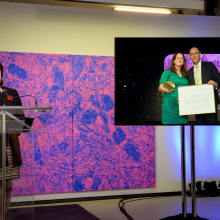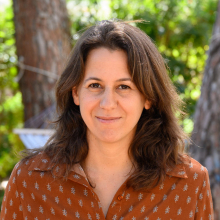The solar forest
Planting solar panels in arid regions could tackle the climate crisis better than planting trees
Briefs

Measuring station in Yatir Forest
What would be the most effective use of a certain plot of land in terms of addressing the climate crisis: planting a forest, which provides a natural means of absorbing carbon dioxide from the atmosphere, or erecting fields of solar panels, which reduce the emission of carbon dioxide into the atmosphere? This dilemma has long been debated by environmental decision-makers around the world.
Now, for the first time—based on findings from arid areas and on comprehensive measurements of the energy flow exchanged between the ground and the atmosphere—we may have an answer. A new study from Prof. Dan Yakir’s lab in the Department of Earth and Planetary Sciences, together with members of the Department of Physics Core Facilities, published last year in PNAS Nexus, takes on this very question.
The Weizmann researchers began by comparing the impact of a natural forest situated on the border of an arid area to that of a field of solar panels (a solar farm or solar forest) in the nearby arid environment. Prof. Yakir’s lab has already shown that forest plantations in semiarid land can absorb nearly as much carbon as those in temperate regions. In addition, arid areas are characterized by a large amount of sunlight and a relative paucity of plant diversity and biomass, which makes them especially suited for large solar farms. Such fields already exist in southern Israel in the Arava and Negev deserts, and the government has plans to erect more in Jordan through an international collaboration.
Using a specially designed mobile measuring station—set aboard a truck and complemented by aerial drone measurements—the team measured the energy flux between the ground and the atmosphere in the Arava and inside the solar farm itself; this required overcoming operational and safety challenges related to the sensitivity of the panels, which had interfered with such measurements in the past. The team repeated the measurements in and near the Yatir forest, and then repeated the experiments during different seasons. Finally, they compared their results to data from an analogous process that occurs in wooded areas and the artificial solar forest.
They discovered that the suppressed sunlight-reflecting effect (the “albedo”), due to the darkened surface of both “forests” was similar, but the absorption or prevention of carbon emissions was very different, favoring the solar farm, even when considering the environmental costs of the production of the solar panels and its infrastructure.
Furthermore, the researchers analyzed the equilibrium points at which the opposing effects on the Earth’s climate—heating from both forests’ dark color and cooling from reduced atmospheric carbon dioxide—balanced out one another, ultimately lowering the temperature and helping mitigate climate change. Remarkably, the equilibrium achieved by the solar farm in two and a half years would have taken a wooded area of similar size more than 100 years to achieve.
Using data collected from satellites and databases, the researchers found that in more humid environments such as the tropics or in temperate grassland regions like Europe, natural forests fared better, achieving equilibrium in only 15-18 years. Nevertheless, that time is still longer than what is achievable with solar forests and requires more precious land area.
In sum, the Yakir team’s study shows that in dry environments, where most of the open land reserves exist, building solar farms is far more effective than planting forests when it comes to mitigating climate change. Having said that, the existing natural forests currently absorb, globally, close to one-third of the planet’s annual carbon emissions. The most appropriate solution to the climate crisis is therefore to combine the planting, rehabilitation, and preservation of forests in humid regions with erecting fields of solar panels in semiarid and arid regions.
DAN YAKIR IS SUPPORTED BY:
- Schwartz Reisman Collaborative Science Program
- Hilda and Cecil Lewis Professorial Chair








